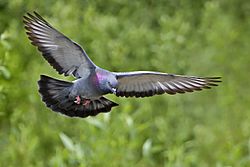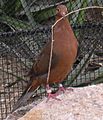Dove facts for kids
Quick facts for kids Pigeons and doves |
|
|---|---|
 |
|
| feral pigeon (Columba livia domestica) in flight | |
| Scientific classification | |
| Kingdom: | |
| Phylum: | |
| Class: | |
| Order: | |
| Family: |
Columbidae
|
Pigeons and doves are birds that belong to the family Columbidae. You might hear people use the names "pigeon" and "dove" to mean the same thing. Usually, "dove" is used for smaller birds in this family, and "pigeon" for larger ones. For example, the common pigeon you see in cities is often called a "rock dove."
There are more than 300 different kinds, or species, of pigeons and doves. They typically build their nests from sticks. Both the male and female parents take turns sitting on their two white eggs to keep them warm until they hatch. Pigeons and doves eat seeds, fruit, and different parts of plants.
What's really cool about these birds is that, unlike most other birds, they make their own special "milk." This "milk" is called crop milk and is made in a part of their throat called the crop. Both male and female pigeons and doves produce this very nutritious milk to feed their young chicks.
Contents
Where Pigeons and Doves Live
Pigeons and doves can be found almost everywhere on Earth! The only places they don't live are the very driest parts of the Sahara Desert, Antarctica and the islands around it, and the far northern Arctic. They have even made their homes on most of the world's islands in the Pacific Ocean, Indian Ocean, and Atlantic Ocean.
These birds have learned to live in many different kinds of places. Some live mostly in trees (these are called arboreal birds), while others spend most of their time on the ground (these are called terrestrial birds). You can find them in savannas, grasslands, deserts, temperate woodlands, and forests. They also live in mangrove forests and even on the sandy or rocky beaches of small islands called atolls.
The rock dove is a great example of a bird that lives in many places. Its natural home includes Britain, Ireland, northern Africa, all across Europe, Arabia, Central Asia, India, the Himalayas, and into China and Mongolia. But its range grew much bigger after people started keeping them as pets. Many of these birds escaped and now live wild in cities all over the world, including North America, South America, Africa, Southeast Asia, Japan, Australia, and New Zealand.
Humans have helped other pigeon species spread too. Some have escaped from captivity and started living in new areas. Other species have also expanded their natural homes because humans changed the environment, creating new places for them to live.
The Dodo and the Solitaire
You might have heard of the dodo and the Rodrigues solitaire. These were two famous flightless birds that lived on islands in the Indian Ocean, east of Madagascar. Sadly, they are now extinct, meaning they no longer exist. They were alive before sailors discovered their islands.
These birds had never seen humans before, so they weren't afraid. Sailors hunted them for food, which led to their disappearance. Animals that humans brought to the islands might have also hunted them. Scientists have studied their bones (anatomy) and DNA and found that the dodo and solitaire were actually part of the Columbidae family, just like pigeons and doves!
Pigeons as Symbols
Throughout history, pigeons and doves have been important symbols. In ancient times, around the Ancient Near East and Mediterranean region, doves were symbols for goddesses like Asherah, Tanit, Venus, and Fortunata. These goddesses were often linked to love, fertility, or good luck.
A very well-known symbol is a dove holding an olive branch in its beak. This represents peace. This idea comes from the Book of Genesis in the Bible, where a dove brings an olive branch back to Noah after the great flood, showing that land was safe again. Similar stories about doves finding land also exist in older myths, like the Epic of Gilgamesh from ancient Chaldea.
Pigeons as Food
Many kinds of pigeons and doves are eaten as food, and almost any species could be. The strong chest muscles of these birds make for good meat. People have eaten domesticated or hunted pigeons for a very long time, in places like Mesopotamia, Ancient Rome, and medieval Europe.
Pigeon meat is still eaten in many cultures today, including Jewish, Arab, Assamese, and French cuisines. In the Tanakh (Jewish scriptures), doves are considered kosher and are the only birds that could be used for a special offering called a korban. You can also find pigeon meat in Asian foods, like Chinese and Indonesian cuisine. Young pigeons raised for food are called "squabs."
In Europe, the common wood pigeon is often hunted as a game bird. The rock pigeon was first raised by humans for its meat. Sadly, the passenger pigeon in North America became extinct partly because too many were hunted for food. In the past, famous cookbooks like Book of Household Management by Mrs Beeton included recipes for roast pigeon and pigeon pie, which was a popular and cheap meal in Victorian Britain.
Other pages
Images for kids
-
The common bronzewing lives in most parts of Australia.
-
The zebra dove has been introduced to many places around the world.
-
Rock dove (Columba livia) in flight
-
The common ground dove (Columbina passerina) is one of the smallest pigeons.
-
The Common wood pigeon (Columba palumbus) is common in Europe.
-
A landing collared dove (Streptopelia decaocto) showing its wings.
-
The Socorro dove (Zenaida graysoni) is extinct in the wild.
-
Emperor Honorius kept pigeons as pets.
-
Dove with an olive branch from the Catacombs of Domitilla in Rome.
See also
 In Spanish: Palomas para niños
In Spanish: Palomas para niños














